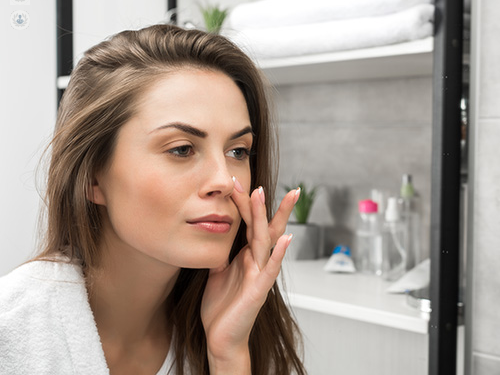18 things to expect after a rhinoplasty or septorhinoplasty operation with Professor Malata
Written in association with:After any type of surgery, it is important to fully understand the steps you need to follow to hasten your recovery and avoid unnecessary complications - and a nose job is no exception.
Professor Charles Malata, one of our top consultant plastic surgeons, can perform rhinoplasty or septorhinoplasty under general or local anaesthetic, depending on your preference and the extent of the surgery needed. He prefers to use the open approach which involves making a skin incision between your nostrils because of the increased accuracy. He also sometimes performs “closed” rhinoplasty with no external incisions in appropriate patients.

In this article, Professor Malata lists 18 important things to expect straight after you wake up from your operation, which includes what the incision mark will feel like and how you should manage it, the time you will need to take off work, the activities you will and won’t be able to do, and at what point your new nose will finally be revealed:
- You will have to stay overnight in hospital — The surgery for reshaping the nose can last between 2-4 hours and you will need to spend the following night in the hospital. You might experience postoperative nausea for 6-8 hours after surgery.
- Your nose will be bandaged up — At the end of the surgery, I will tape a gauze to the front of your nose to catch any fluid drips. I will also put a hard-plastic splint along the top of your nose to hold the tissues in place and provide support until they have stabilised. This also protects the newly reshaped nose while you sleep to shield it from accidental bumps.
- You will not be able to breathe through your nose for a while — I will place a pack inside your nostrils to help reduce any bleeding, however, you will have it removed the next day before you are sent home. It could be the case that it is left in for longer, possibly 48 hours or more, if you’ve had work done on the septum to improve your breathing, straighten a crooked nose, harvest cartilage grafts for building up your nose or there was more bleeding than expected.
- You won’t be able to exercise for a few days — For the first 3-4 days after surgery, you must avoid any strenuous activity such as running, lifting, bending or straining. While you are at home, you should be propped up when sitting and use at least two pillows to elevate your head when you’re in bed. Doing this will minimise any swelling, bruising and oozing. If you notice a small amount of bleeding/discharge, don’t worry as this is relatively common, especially after removing nasal packs for a day or two.
- You shouldn’t take any other pain medications — Only take the pain medication that I have prescribed you and for the following two weeks, you must avoid drugs such as aspirin, ibuprofen or voltarol. These can induce or increase bleeding. I will prescribe a course of antibiotics, usually Augmentin, which you need to complete.
- You have to keep your nose area dry — Try to keep the dressing and splint on your nose dry. You can wash your face around the splint and your hair should be washed in the same way they do it in a salon - with head backwards over a sink. You should ask a family member or friend to help you with this.
- You might experience minor bleeding (oozing) from the nose in the first 24-48 hours after surgery — This is very common, especially if your nose job was combined with septoplasty or turbinectomy. If you are worried about any symptoms such as bleeding, excessive pain, nasal discharge, swelling, redness, fever, breathing difficulty, etc then please contact me on the number given to you and I will help.
- Don’t attempt to blow your nose for a while — Blowing your nose should be avoided for around 2-3 weeks, particularly if septal surgery or turbinate work has been done. This also applies to rubbing or blotting your nose, and try your best to sneeze through your mouth. In addition, I recommend that you tape your glasses to your forehead and avoid heavy lifting for 2–3 weeks.
- You will need to return to the hospital to have the stitches removed — If you have had an open rhinoplasty, either myself or a nurse will remove the stitches on the base of your nose 5-7 days later during your first outpatient visit. The tip of the nose may appear swollen and turned up. This is temporary. You may experience numbness in that area too for several weeks to months after.
- It usually takes 7-10 days before you will be able to see your new nose for the first time — The splint on the nose is removed at 7–10 days after surgery, which is when you will have the first opportunity to inspect your new nose in a mirror. At this time it will still be swollen, variously bruised and will bear the imprints of the splint. Please be patient and do not be overly concerned by the swelling, bruising, initial shape, etc. at this early stage. You can, however, then begin to use makeup as a concealer, if desired and appropriate.
- Don’t be alarmed if you see severe swelling of the nose and around the eyes — The bruising and swelling around the eyes and cheeks is most apparent during the first three days following surgery and is very common. Most of the discolouration disappears within 1-2 weeks.
- Arrange to have 2 weeks off work — You can go back to work after 2 weeks, which is when most of the bruising and swelling will have subsided. Most normal activities and even exercise can be resumed within 3-4 weeks.
- Avoid contact sports for 4-6 weeks — Your nose will still be fragile so you should avoid contact sports or any accident-prone activities for a minimum of 4-6 weeks. Any kind of blow to the nose might disrupt grafts and recontoured nasal bone areas.
- Expect several outpatient appointments to check your progress — Your outpatient appointments will be at 2 and 6 weeks, 3 months and then finally at 6 months to monitor your recovery. I will advise you when and how to start massaging the scars (usually at 6 weeks). With your permission, I will take postoperative photographs for general documentation.
- Do not expose your nose to sunlight for 3-6 months — Your nose will be sensitive during your recovery, so you must be conscientious about using sunscreen (SPF>15) to protect the skin on your nose and avoid hyperpigmentation of the incision areas. Direct sunlight should be avoided for 3-6 months.
- You will need special support to wear glasses — If your nose bones were altered (broken) during its reshaping, it may be several weeks before you can wear glasses without special support such as tape.
- Normal nose sensation will disappear for at least 3 months — Your new nose will continue to evolve and there will be minor residual swelling, especially around the nasal tip and dorsum, which will slowly subside over 6 - 12 months. You must be patient as the final result may take 6-12 months to be fully apparent. Normal sensation will return in 3 – 6 months.
- Revision or touch-up surgery is still an option — Although it is unlikely, you can undergo further revisional surgery to alter any aspect of your cosmetic surgery if you feel it’s necessary. There may be additional expenses incurred so you will need to discuss this with me if this is the case.
If you are interested in a rhinoplasty ('nose job') or septorhinoplasty operation, visit Professor Charles Malata’s Top Doctors profile and book a consultation with him to discuss it.


